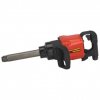I just bought a (very large) 1" impact wrench from harbor freight. It's supposed to deliver about 1,400 ft/lbs of torque on about 10 CFM at 100psi. I bought it because I occasionally have to do some heavy work (crank pulley bolt on a mercedes V8 takes about 275 ft/lbs, for example...). The latest one is that I would like to remove the CV axles from my CAV to replace/rebuild the CVs...and the outboard nut (hub end) is on hella tight. It looks very dry and a little corroded. I've tried a three foot breaker bar with my full weight (~600 ft/lbs) and no dice. So, I'd like to try the impact wrench on it.
My problem is that I think I must be short on air. The impact wrench has a 1/2 inch NPT inlet which I reduced down to 3/8th with a reducer....then further reduced it down to the regular 1/4 fitting size (what you normally have on say a 1/2 inch impact wrench). I have a newish 5hp Craftsman air compressor with a standard size air hose (1/4 air fittings). With pressure cranked up and full tank of compressed air, the impact wrench barely turns. It certainly doesn't deliver any meaningful impact torque.
Do I need to re-plumb from the tank out with a larger diameter hose? Get a bigger air compressor?
If nothing else, I'll remove the wheels and the pin drive hub and then use a dremel tool on the nut with a cold chisel to crack it....was just hoping to be able to use my new big toy instead...
Any advice/help is appreciated.
My problem is that I think I must be short on air. The impact wrench has a 1/2 inch NPT inlet which I reduced down to 3/8th with a reducer....then further reduced it down to the regular 1/4 fitting size (what you normally have on say a 1/2 inch impact wrench). I have a newish 5hp Craftsman air compressor with a standard size air hose (1/4 air fittings). With pressure cranked up and full tank of compressed air, the impact wrench barely turns. It certainly doesn't deliver any meaningful impact torque.
Do I need to re-plumb from the tank out with a larger diameter hose? Get a bigger air compressor?
If nothing else, I'll remove the wheels and the pin drive hub and then use a dremel tool on the nut with a cold chisel to crack it....was just hoping to be able to use my new big toy instead...
Any advice/help is appreciated.

